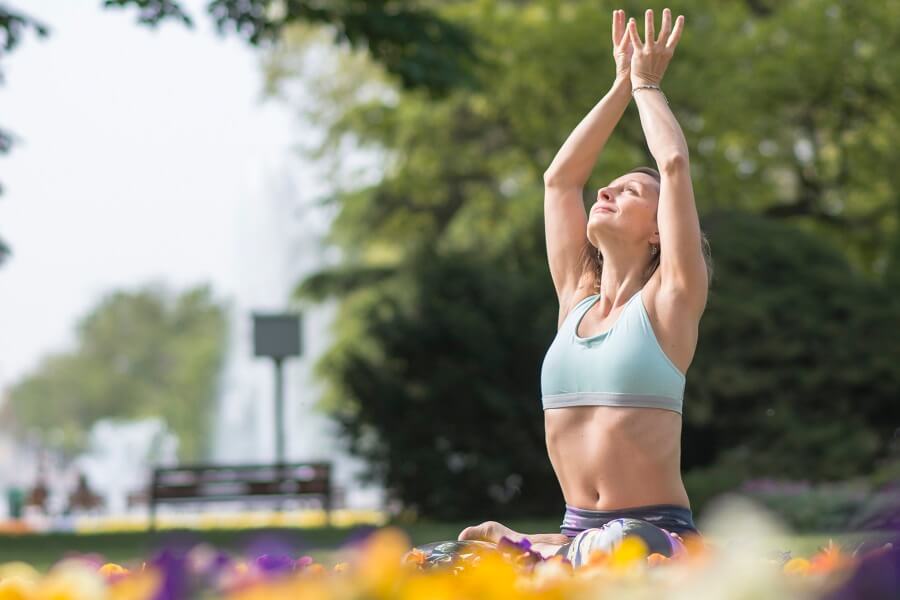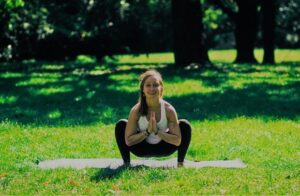Have you noticed that when life gets busy, turbulent or increasingly difficult, your body tightens and the headspace tends to shrink? In these cases we often react out of agitation and fear, which is not usually productive. Grounding yoga poses are simple and available tools to center ourselves and calm the mind.
So how can we overcome difficulty, get out of our own heads and into the body?
There are various tools for “resourcing”, that is, finding ways to a peaceful mind and open heart, in which place we are more at ease and less reactive.
For instance, breathing consciously can be such a pathway: taking a few full, soft breaths in and gently releasing them fully. Or maybe, in a moment of apprehension or conflict, you call a calming image to your mind or place a hand on your heart, for a feeling of support.
Personally, I feel that finding ways to get fully into the body and ground myself is probably the first step to start calming the mind and getting out of a headspin.
Think of never ending deadlines and social obligations, hobbies that eventually may resemble chores. The more we can create a sense of rooting down and centering through grounding yoga poses, the more space we create in between constant stimuli and our response.
The following sequence contains five poses that evoke a sense of grounding and support. You can practice them in the morning or even in the evening without over-energizing yourself. Depending on how you feel, you can take as long as 20 minutes or perhaps 8-10 minutes will do if that’s just how much time you have available.
Watch out for the changes and effects after some consistent practice of grounding yoga poses. You may notice that your mind becomes clearer and your breath softer, and in general you may feel calmer and more centered.
In addition to the breath and heartful movement, there is something very powerful that can counter the pressure of the fight, flight and freeze mechanism that often curbs our joyful moments. The presence of an accepting community where kindness and compassion are abundant can help us to relax and feel that we belong.
Come to your mat, take a few breaths – take a moment to arrive.
Kneel on the floor either with knees together or separated as wide as hip-width apart. Bring your sitting bones back towards your heels. Forehead can rest on the ground. You may reach your arms all the way out in front of you or rest them next to the side body, palms facing up, relaxing shoulder heads down towards the floor.
Lengthen your tailbone away from the back of the pelvis while you energetically lengthen your neck. Feel your sacrum broaden and sense into how you ar connected to the ground: feel the tops of the feet, shins, knees, thighs and arms, head. Feel your torso rest on your thighs. Breathe deeply and stay for 1-3 minutes.
Come out of the pose and onto all fours, and feel free to do some cat-cow tilts to loosen up the spine.
Malasana, sometimes called yogi squat, is a great grounding yoga pose to bring on calm as it taps into the downward-flowing energy, and supports the metabolism and clearing the mind.
Squat on your feet. Use a rolled blanket, as needed, under your heels. Root down through the entire sole of the foot and rise up through the crown of the head. Place palms together and the elbows against the inner thights – the lower you go, the deeper the stretch across the lower back.
Engage the pelvic floor and lift the lower abdomen in to protect your back and prevent the energy flowing all the way out. Stay for a few seconds and up to two minutes.
To take pressure off your knees, you may place a folded blanket behind the back of your knees and then squat.
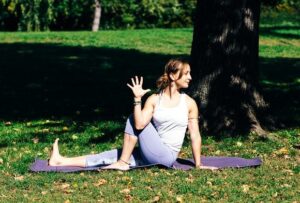 Marichyasana C: pose of sage Marichi
Marichyasana C: pose of sage Marichi
In this seated twist, we open to the sensation of rooting down while the spine is gently twisting upwards to the sky, lifting our energies up and working on the digestive system.
Make sure you feel both sitting bones firmly grounded, start with left leg straight and engaged and right knee bent. Leave a fist distance between right foot and left thigh. Slide your right arm back and without placing too much weight on that arm, inhale your left arm up and exhale into the twist.
You may want to keep your left arm bent, hugging the right knee to the chest. Or bent left elbow and wedge the upper arm against the left thigh. Lengthen on the inhale and ground with the exhale. Repeat on the left side.
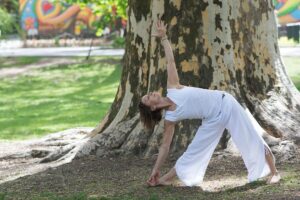 Utthita Trikonasana: extended side angle pose
Utthita Trikonasana: extended side angle pose
The three triangles within utthita trikonasana represent stability, expansion and a sense of equilibrium. When entering into the pose, we may feel wobbly, and at times want to grasp deeper and almost fall out of the pose – in the end, if we ground down and listen, we gain balance.
Step your feet out as one-leg distance apart, then rotate right foot all the way to the right and the left foot in 30 degrees. Inhale your arms to the side and firm them up, exhale. On the next inhale, hinge from your right hip, extending the side body while keeping legs engaged. Exhale your right hand down to the shin or to catch your right big toe. Press the inner right heel and the outer left foot into the mat and feel free to bend your front knee slightly.
Make sure you keep the left side of the ribcage open and rotated to the sky, as if you are standing against a wall. Keep your neck long and look to the side or up to the sky. For moe stability, use a block next to your front foot, placing the hand on the block. Inhale and press into your back foot, firm up the thighs and pelvic muscles and rise up gently.
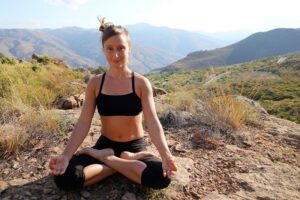 Any seated position, for instance cross-legged, half lotus or lotus (padmasana)
Any seated position, for instance cross-legged, half lotus or lotus (padmasana)
Take at least a minute or more to simply feel your sitting bones ground down in your seated position. Feel the contact points between floor and body, scan the entirety of your body. Feel that you are sitting up tall without effort, allow the body to rest in a graceful and comfortable way. Scan your shoulders, allow them to drop down away from the ears, rest the hands on the knees or in your lap. Feel their weight.
Allow the fascial muscles to soften, the jaw to be relaxed, and take a couple of soft, deep breaths. Feel the fresh energy running through your body and release all tension on the exhale, softening and grounding more. Let the thoughts come and go, then invite your attention back to the body sensations.
Photos: Arwa Hamouda, Ágota Farkas, Jacob Donaghy-Sutton

